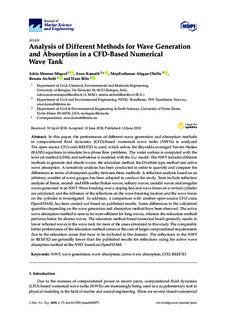| dc.contributor.author | Miquel, Adria Moreno | |
| dc.contributor.author | Kamath, Arun | |
| dc.contributor.author | Alagan Chella, Mayilvahanan | |
| dc.contributor.author | Archetti, Renata | |
| dc.contributor.author | Bihs, Hans | |
| dc.date.accessioned | 2018-06-15T10:44:55Z | |
| dc.date.available | 2018-06-15T10:44:55Z | |
| dc.date.created | 2018-06-14T15:47:38Z | |
| dc.date.issued | 2018 | |
| dc.identifier.citation | Journal of Marine Science and Engineering. 2018, 6 (2), . | nb_NO |
| dc.identifier.issn | 2077-1312 | |
| dc.identifier.uri | http://hdl.handle.net/11250/2501754 | |
| dc.description.abstract | In this paper, the performance of different wave generation and absorption methods in computational fluid dynamics (CFD)-based numerical wave tanks (NWTs) is analyzed. The open-source CFD code REEF3D is used, which solves the Reynolds-averaged Navier–Stokes (RANS) equations to simulate two-phase flow problems. The water surface is computed with the level set method (LSM), and turbulence is modeled with the k-ω model. The NWT includes different methods to generate and absorb waves: the relaxation method, the Dirichlet-type method and active wave absorption. A sensitivity analysis has been conducted in order to quantify and compare the differences in terms of absorption quality between these methods. A reflection analysis based on an arbitrary number of wave gauges has been adopted to conduct the study. Tests include reflection analysis of linear, second- and fifth-order Stokes waves, solitary waves, cnoidal waves and irregular waves generated in an NWT. Wave breaking over a sloping bed and wave forces on a vertical cylinder are calculated, and the influence of the reflections on the wave breaking location and the wave forces on the cylinder is investigated. In addition, a comparison with another open-source CFD code, OpenFOAM, has been carried out based on published results. Some differences in the calculated quantities depending on the wave generation and absorption method have been observed. The active wave absorption method is seen to be more efficient for long waves, whereas the relaxation method performs better for shorter waves. The relaxation method-based numerical beach generally results in lower reflected waves in the wave tank for most of the cases simulated in this study. The comparably better performance of the relaxation method comes at the cost of larger computational requirements due to the relaxation zones that have to be included in the domain. The reflections in the NWT in REEF3D are generally lower than the published results for reflections using the active wave absorption method in the NWT based on OpenFOAM. | nb_NO |
| dc.language.iso | eng | nb_NO |
| dc.publisher | MDPI | nb_NO |
| dc.rights | Navngivelse 4.0 Internasjonal | * |
| dc.rights.uri | http://creativecommons.org/licenses/by/4.0/deed.no | * |
| dc.title | Analysis of Different Methods for Wave Generation and Absorption in a CFD-Based Numerical Wave Tank | nb_NO |
| dc.type | Journal article | nb_NO |
| dc.type | Peer reviewed | nb_NO |
| dc.description.version | publishedVersion | nb_NO |
| dc.source.pagenumber | 21 | nb_NO |
| dc.source.volume | 6 | nb_NO |
| dc.source.journal | Journal of Marine Science and Engineering | nb_NO |
| dc.source.issue | 2 | nb_NO |
| dc.identifier.doi | 10.3390/jmse6020073 | |
| dc.identifier.cristin | 1591290 | |
| dc.description.localcode | (c) 2018 by the authors. Licensee MDPI, Basel, Switzerland. This article is an open access article distributed under the terms and conditions of the Creative Commons Attribution (CC BY) license (http://creativecommons.org/licenses/by/4.0/). | nb_NO |
| cristin.unitcode | 194,64,91,0 | |
| cristin.unitname | Institutt for bygg- og miljøteknikk | |
| cristin.ispublished | true | |
| cristin.fulltext | original | |
| cristin.qualitycode | 1 | |

